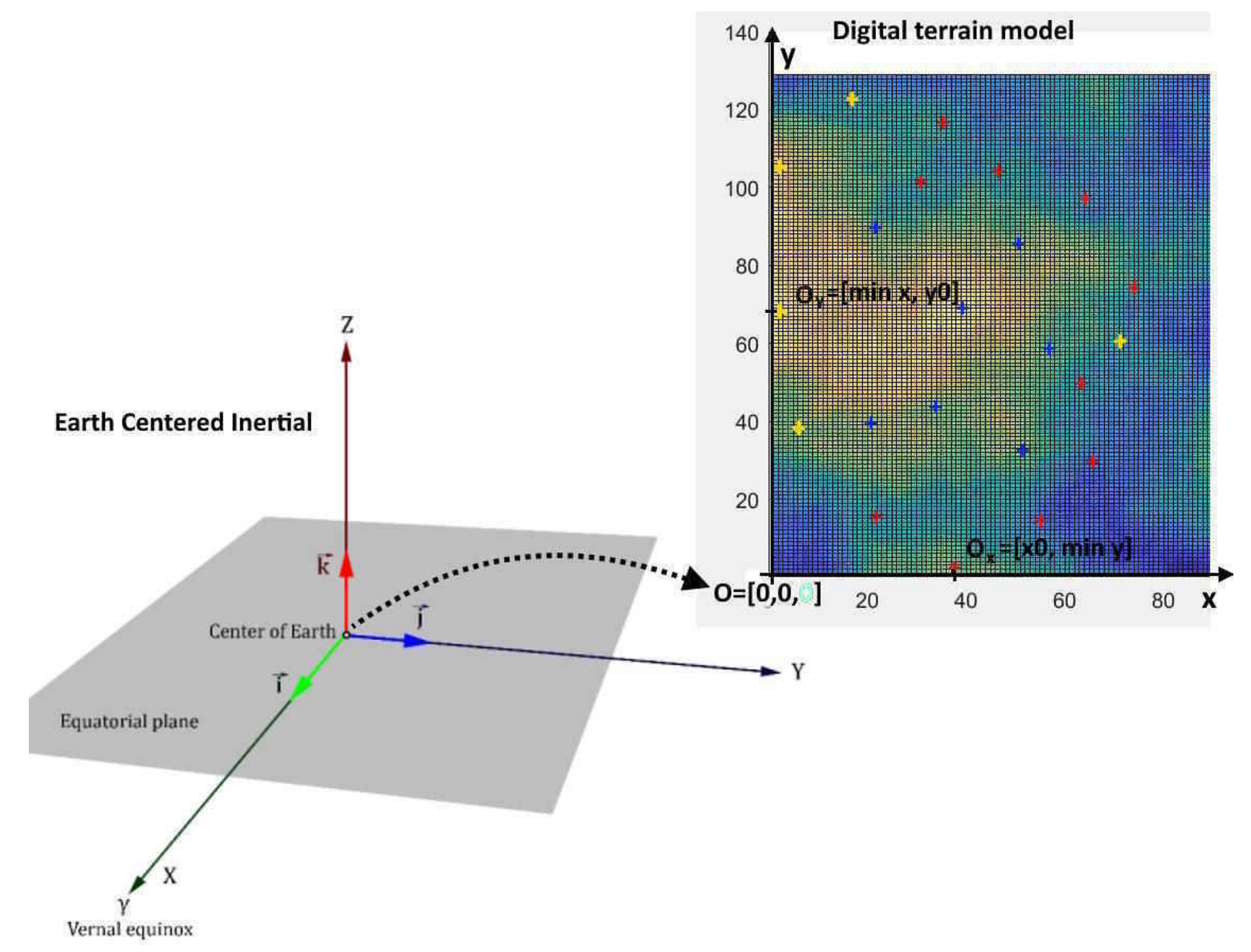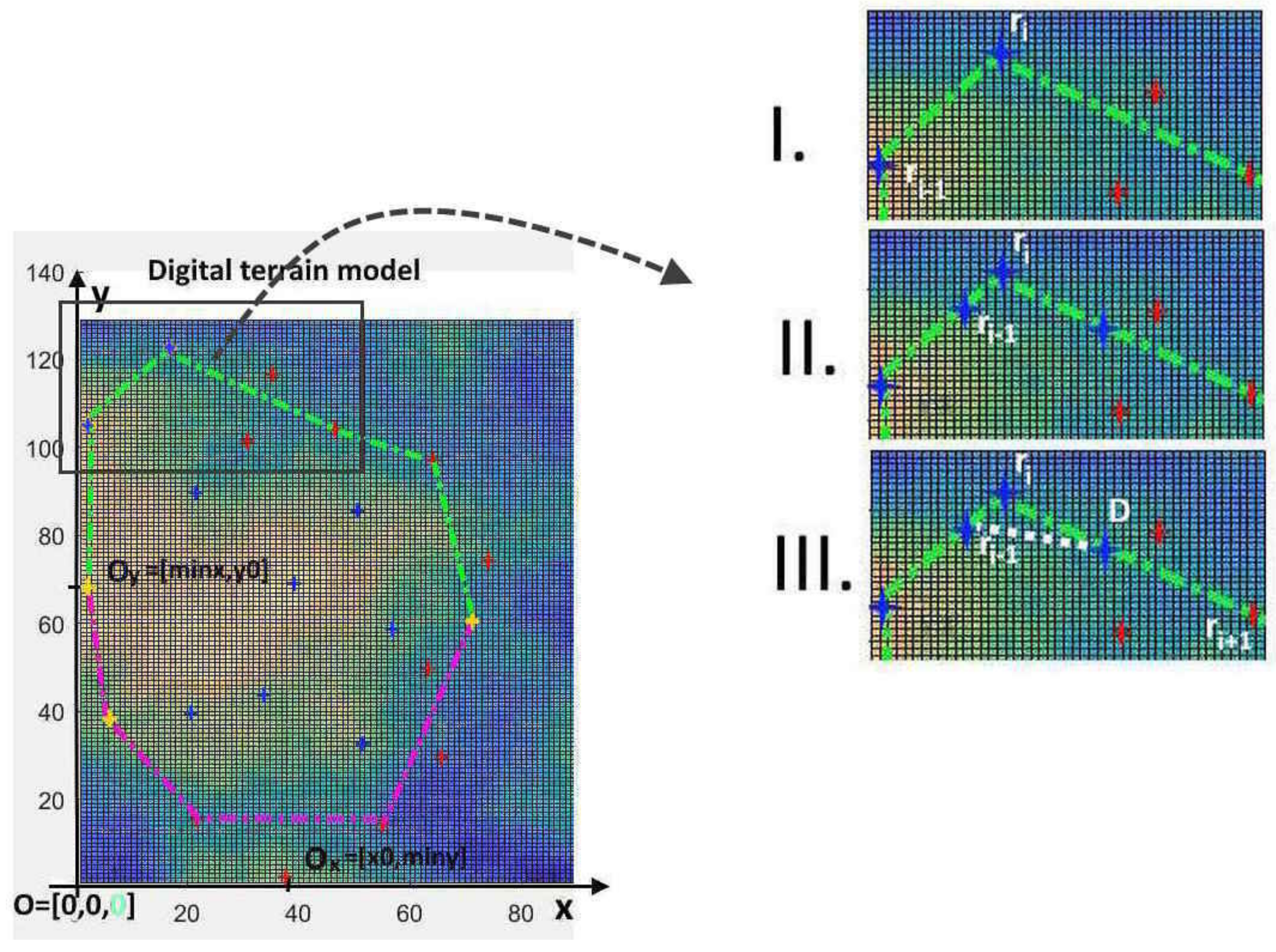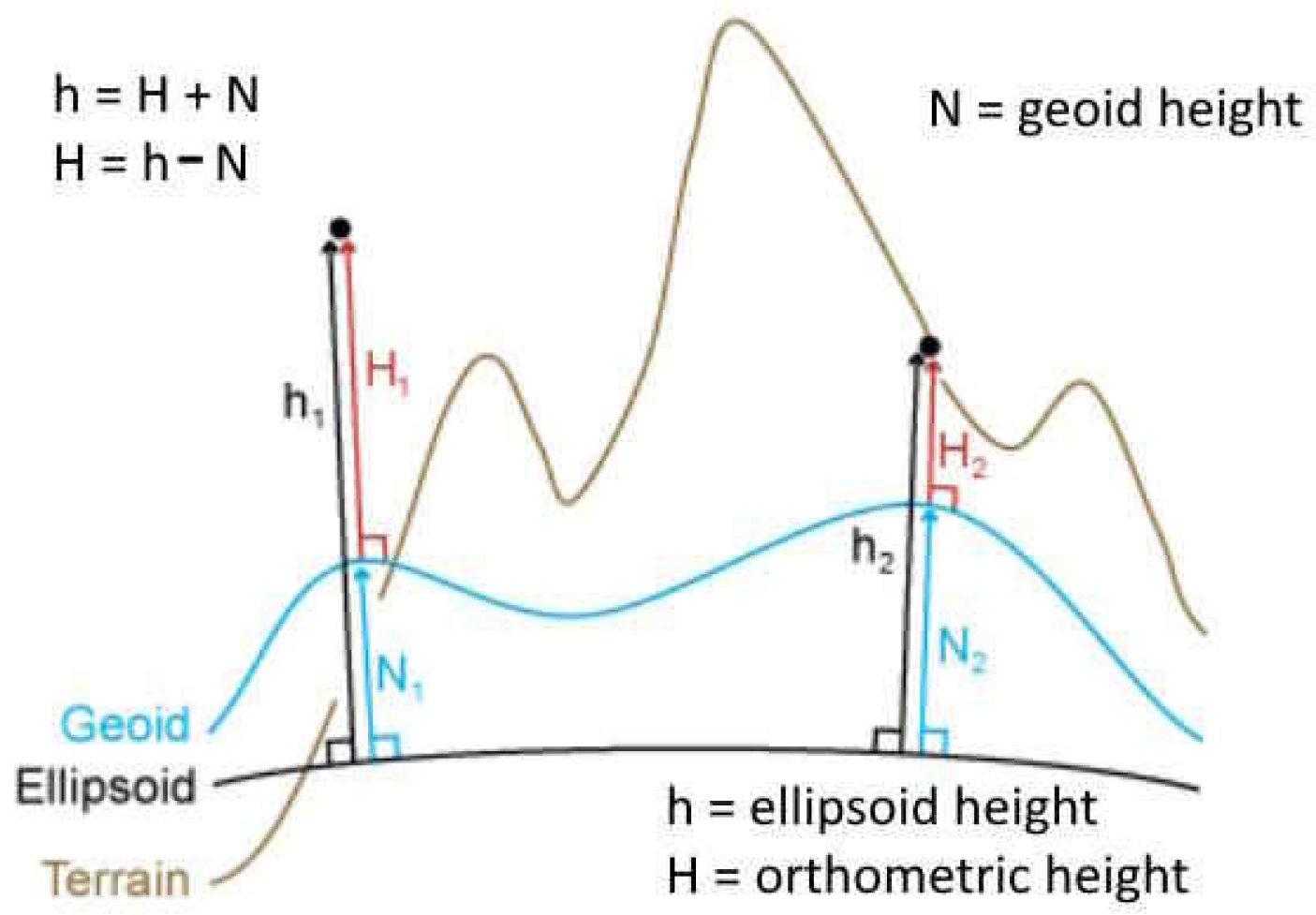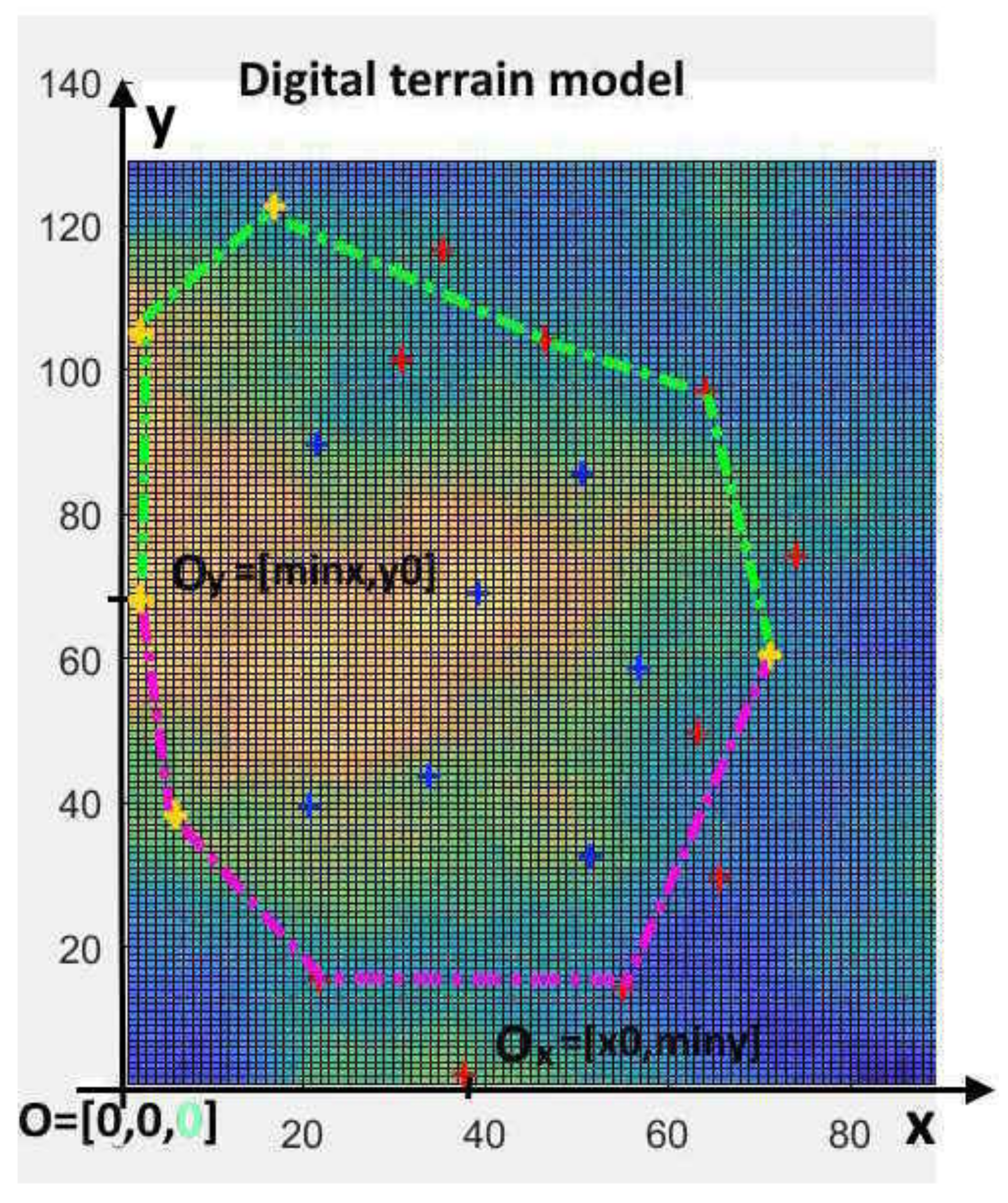4.1. Area of Interest-Estimation of the Number of Sensory Units
Our project MOVIR aimed to test mobile sensory units and the network of sensory elements in a small monitored area. A small monitored space means a rectangular area with edges of a few dozen meters. The methodology for testing projects like MOVIR is to test the project in laboratory conditions, then 1/2 size and finally full size. Due to the area’s size, the MOVIR project’s testing is now 1/2 the size. However, the procedures that form the network of sensor units are independent of the size of the area of interest. In this chapter, we define the mathematical and data model of the area of interest.
The basic principle of determining the area of interest is the principle used by Free Route Airspace (FRA) see [
17] when defining the horizontal part of the airspace. It is needed to enter special significant points of space which belong to the given area. These points will be given by GPS coordinates. Significant points with coordinates
will be divided into three sets. One of the sets will be the internal points (blue color in the
Figure 1, obstacles in the terrain can be entered this way). In the second set are possible boundary points of the area (marked with red color), and in the third set are necessary points that must be included into the sensory network units (yellow color). We assume that some boundary points will form a simple closed polygon determined by the system user. It will be the polygon of the area of interest.
The number
is the number of significant points and
i is the ordinal number of the given significant point (from 0 to
n). Unlike FRA, this polygon has three dimensions (FRA points only have GPS coordinates, heights are solved otherwise). We consider the height because of the terrain profile. If we denote the length of the polygon as
, the communication range of the signaling sensor with
s like
and the sensitivity of the sensor element
s with
, then we can set the maximum distances between signaling sensors as
. While parameter
can take on values from the interval
. The value of
means that neighboring sensory units work at a distance of
. Using these parameters, we can estimate the number of sensory units needed to create the network of mobile sensory units.
This value is the minimum number of sensory network units. Here we assume that there are used the same length measurement units for the length of the polygon and the range of sensory units. We note that the length of the polygon is the circumference of the area of interest. The number of the nodes of the closed simple polygon P is marked with . Polygon which does not contain any nodes is marked
4.2. Digital Terrain Model
We suppose that input significant points to the area are given. The are GPS coordinates of individual significant points, is their altitude for . By using these points, we will create a 3D model of the terrain in which signaling sensors will be placed. There will be created a network of sensory units. It is also necessary to consider the spatial resolution of the technology that will create the digital model of the terrain. This parameter is denoted as d—detail of terrain modeling. Dimensions of the sensory element (width and depth) are approximately cm so in this case, we can set the detail to by default. This parameter means that a rectangle of size cm can be covered with two frames that have size cm. For the value of d, it is true that . The set contains points on which the sensory units must be placed. The set will mean internal significant points. Therefore, is a set of boundary significant points.
To model the mobile sensory units network in the Euclidean space, we need to define a coordinate system, the center of the coordinate system and
-axis. The center of the coordinate system will be the center of the Earth, the
x-axis will be vernal equinox in the equator plane, the
y-axis will be perpendicular to the
x-axis in the equator plane, and the
z-axis will be perpendicular to
x and
y-axes. This coordinate system is called Earth centered inertial. The more general name of this system is the Ecliptic coordinate system. The coordinate system can be implemented in Cartesian and spherical coordinates, see [
6,
9].
For the sake of simplicity, we move the origin of the coordinate system to a point defined based on entry significant points. Calculation of the origin of the new coordinate system and the digital terrain model contains these steps. Algorithms in article will be entered in the English natural language.
Notes: Different heights can be distinguished by color during the modeling of the terrain (see
Figure 1). Height gradient of the terrain will be
. For each point
it holds that:
Our digital terrain model is raster (grid) and contains a regular distribution of points.
We can see in the
Figure 1 the shift of the origin of the coordinate system to the point
(steps of the Algorithms 1–3). This shift is necessary to calculate distances easier and locally with the help of the digital terrain model in applications. In the Digital terrain model section, a
matrix
A is displayed. Significant points are marked as signs: +. Red points can be border and blue points internal significant points of the area (
) and the significant points marked with yellow must be included in the network of sensory units (
).
| Algorithm 1: Creating a digital model of the terrain around the area of interest. |
input: S, d,
output:
1. Declaration of coordinates of S in the Cartesian system:
2. Marking of , , and
3. Let’s mark , a , and point .
4. In this way a Euclidean coordinate system with the origin O will be created, see [7]. Dimensions of the digital terrain model will be . Points of the set , are created based on relation (4).
5. The digital model of the terrain is going to be an matrix of type . The significant points are going to be elements of the matrix A and their values are going to be the height of the terrain
|
Figure 1.
Digital terrain model and the origin O.
Figure 1.
Digital terrain model and the origin O.
A digital image of the terrain (matrix
A of type
in units of
d) can be created by using the point
, with dimensions
. It is necessary to find point
in the field too (it is a point with GPS coordinates [min
x, min
y,
]. It is necessary to digitally scan the terrain so the point
will be located in the lower-left corner of the digital model. The
x-axis is defined by a straight line between point
O and point
(this point has GPS coordinates [min
x,
] and points
form one plane) and
y—axis is placed between point
O and point
(this point has GPS coordinates [
, min
y] and the points
form one plane). The scanned area will be a rectangle of size
in
d units. The digital terrain model described here can be seen in the
Figure 1 image. The
points define the
x-axis, the
points define the
y-axis. A Matrix
A can be assigned to this coordinate system (see (
6)), which defines the height of the terrain points. Different heights in our image are displayed in different colors. The coordinates [
, min
y] are the coordinates of a significant point, if there are several such points
, we choose
arbitrarily. The value of min
y determines the location of the
x-axis. The situation is similar with the
y-axis and the point [min
x,
]. The resulting two-dimensional coordinate system is necessary for modeling the observed area and the sensor network. Considering the size of the area, we can use a two-dimensional coordinate system.
A digital image of the terrain must be created to obtain a matrix
A. In the matrix
A it is necessary to mark significant points
according to the assignment (
5) and significant points that must be included in the area of interests
and internal significant points
. Conversion of GPS coordinates to the Cartesian system (
4) is possible, e.g., in MATLAB using the command:
This command is used to convert geodetic coordinates to the Earth-centred, Earth-fixed coordinate system (ECEF). In this case, the height h is the ellipsoidal height of the point, are the GPS coordinates of the point and the parameter spheroid is a parameter of the MATLAB system, which stands for the fact that we are examining in our considerations globe.
When we have available the ellipsoid heights of the points, we can apply the command (
7). Then assignment
Defines the elements of the matrix of type in d units. Matrix A represents the digital model of the terrain. This model using raster data structures.
When the altitude or orthometric height
H is available, we need to calculate the ellipsoidal height
h. The relation ships between heights are shown in
Figure 2. Methods for calculating altitude (orthometric height) can be found in publications such as [
9]. Another option is to apply newer versions of the program MATLAB (newer than R2022b), where theoretical calculations are already implemented and there are functions for this calculation [
12]. Note that the authors of the article have a university license to use the MATLAB program.
Of course, other mathematical systems such as SageMath or Geogebra also enable geographic calculations too. Publication [
6] contains the basic mathematical principles of geography. Detailed theoretical information about geodetic coordinate systems can be found in the publication [
10], and about plane geometry of the type we use in the design [
8].
4.4. Polygon of the Area of Interest
As stated in the work [
17], it is not possible to algorithmically determine a polygon based on significant points of the limited area. Therefore, it is necessary to enter which significant points and in what order will define the polygon that bounds the area of interest. In the mentioned work, it is also stated that a simple polygon can be divided into an upper and a lower part, as we can see in
Figure 3. This is the way to obtain the points
,
which define the polygon of the bounded area.
Now we need to determine the length of the polygon to be able to estimate the number of sensory units of the network according to relation (
2). To calculate the length of the polygon, we need to define the term
spatial curve.
Definition 1. Let be a closed interval. Representation is a spatial curve, is the starting point, is the endpoint of the curve. If then the curve is closed. The curve r is simple, when is a one-to-one correspondence.
The correspondence is one-to-one if each element of the first set is made to correspond with exactly one element of the second set, and vice versa.
Definition 2. Letbe a spatial curve and is the partition of the interval . The spatial polygon which has vertices , is called an inscribed polygon belonging to partition . The length of the polygon is the sum of the lengths of the edges:
A polygon of an area of interest is a simple, closed spatial curve, which is given by the division of the interval
In three-dimensional space, a polygon is given by these points
for
Therefore, we can calculate the distances between the points
and
(see [
9,
10]) as
The points
,
from relation (
10) define three functions
. These functions for our purposes at the moment are not needed, only their functional values in points
, so we do not examine the properties of the functions.
4.6. Algorithm for Creating a Network of Mobile Sensory Units
Suppose that the polygon
P of the area of interest is given. Polygon
P contains significant points
a
. All the necessary significant points that belong to the set
are vertices of the polygon
P. In a digital model of the terrain is given point
. According to this point, the coordinates of the points are given
.
| Algorithm 3: Creating a network of sensory units. |
- input:
P—polygon of the area of interest is given with significant points where . The set of significant points , the set of necessary significant points and the set of internal significant points . Digital model of terrain A, —the reach of the sensory element, —sensitivity of the sensory element. - output:
Q—polygon of the area of interest, which contains points and which form the network of sensory units.
1. for
2. , point selection
3.
4.
5. if then (see, point I. on the Figure 4)
6. if then
if then (see, point II. on the Figure 4)
if then it is possible (there is no obstacle between the points and D)
if there is an obstacle between the points and D, then
(see, point III. on the Figure 4)
7. if then go to 2 (in this step the polygon with vertices was created)
8. if then , . |
Cases I, II and III from
Figure 4 show the procedure for creating a network of sensory units. Coordinates
are elements of the matrix
A of the digital terrain model (see
Figure 3).
Note: Point D lies on the line and at a distance of . Point D is not a significant point.
Brief description of the algorithm: We have a cycle considering the variable j in which we select the vertices of the polygon P. According to points 5–7. we create a polygon . with vertex . Polygons contain a set of necessary significant points and other points where sensory units are located. In point 8, we determine the polygon, which contains the smallest number vertices from that set of polygons .
This method finds a polygon Q such that the length of the polygon is and the number of vertices of Q is less than or equal to the number of vertices of P. The polygon Q is a digital model of the boundary of the area of interest, the vertices of the polygon define the location of the sensor units in the area of interest.
Figure 4.
Selecting the next polygon(network) vertex.
Figure 4.
Selecting the next polygon(network) vertex.
4.7. Data Model of the Network
The coordinate system (coordinate system origin, coordinate system axes), the set of significant points, the polygon of the area of interest and the polygon of the network belong to the mathematical model of the network. We also have other inputs, such as a digital terrain model. This terrain model depends on the detailedness of the terrain d. All these objects need to be defined in the data model of the network.
The raster data model contains the following data structures:
—a table that contains one record in which there are the following items:
. The origins of the coordinate system
are the actual GPS coordinates,
H is its altitude and
d is the detailedness of the terrain, which was applied in the creation of a digital terrain model. This information determines the place where the terrain is located in which the network will be set. Values
need to be calculated according to relations (
4) and (
5). Parameters
H and
d are going to be input parameters. These data define the origin of the coordinate system, it is the
reference point of the system and the
detailedness of the terrain model, in which resolution we will work.
—table (matrix ) of size —digital terrain model. Digital terrain model can be obtained from existing software such as MATLAB (for detail ) or it is possible to apply special scanners such as LiDAR, where we can achieve a detail of , which means we can divide a 100 cm section into 10 parts, or in other words, the resolution of one table point will be cm.
—a table that contains rows of
—set of significant points
coordinates in the table
,
—significant point coding, 1—internal (blue color), 2—necessary boundary (yellow color), 3—borderline (red color in
Figure 1 and
Figure 3). We note that a suitable choice of significant points helps to define different types of obstacles in the field.
With the help of significant internal points, we can define obstacles as things, events or constructions. Different observation layers can also be created. In that case, matrix A will be three-dimensional. The third dimension can contain layers; for example, the first layer includes the elevation, the second layer structural obstacles and the third layer natural obstacles. In the case of layers, the data complexity of the system grows.
—table (polygon of the area of interest): contains the lines —coordinates of points from the table , which create the polygon of the area of interest.
—table (polygon of the grid): include lines —some coordinates of points and some position data of points.
We can match this basic raster data model to a mathematical model. For completeness, let us note that there may also be a
vector data model (see [
6]) of the monitored area; but we do not deal with this type of model in this work.
The data model is needed for the next step, for the software implementation of the network modeling application, which can be considered a small geographic information system (GIS). Algorithms applied for GIS systems can be found in the publication [
11].









